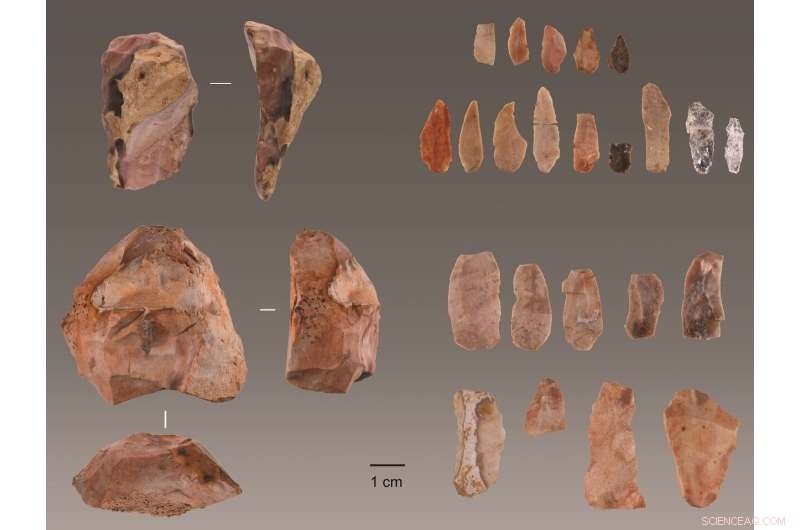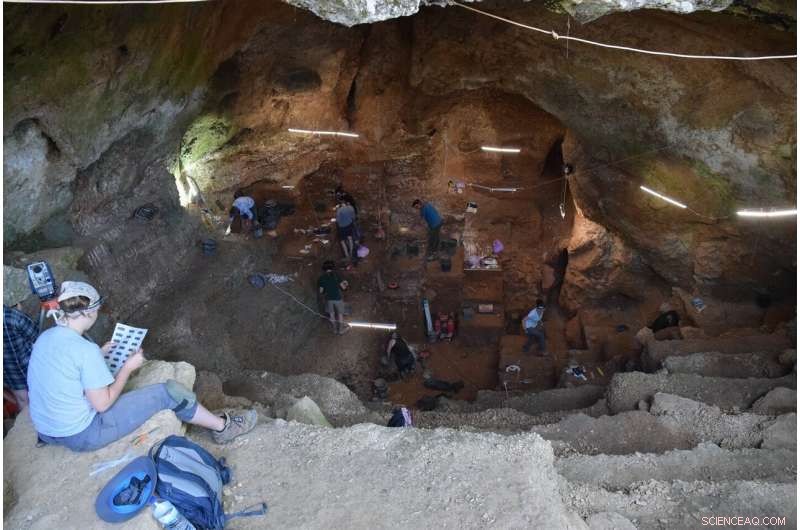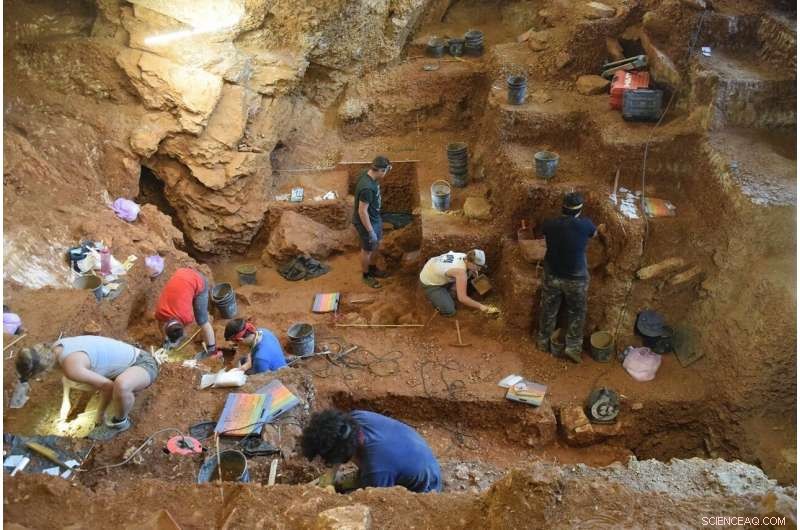Moderne mennesker nåede det vestligste Europa 5, 000 år tidligere end hidtil kendt

Værktøj opdaget i Lapa do Picareiro i det centrale Portugal. Kredit:Jonathan Haws.
Moderne mennesker ankom til den vestligste del af Europa 41, 000-38, 000 år siden, omkring 5, 000 år tidligere end tidligere kendt, ifølge Jonathan Haws, Ph.D., professor og formand for Institut for Antropologi ved University of Louisville, og et internationalt team af forskere. Holdet har afsløret opdagelsen af stenredskaber brugt af moderne mennesker, dateret til den tidligere tidsperiode i en rapport offentliggjort i denne uge i tidsskriftet Proceedings of the National Academy of Sciences .
Værktøjerne, opdaget i en hule ved navn Lapa do Picareiro, beliggende nær Atlanterhavskysten i det centrale Portugal, link webstedet med lignende fund fra hele Eurasien til den russiske slette. Opdagelsen understøtter en hurtig spredning mod vest af moderne mennesker over Eurasien inden for et par tusinde år efter deres første optræden i det sydøstlige Europa. Værktøjerne dokumenterer tilstedeværelsen af moderne mennesker i det vestligste Europa på et tidspunkt, hvor man tidligere mente, at neandertalere var til stede i regionen. Fundet har vigtige konsekvenser for forståelsen af den mulige interaktion mellem de to menneskegrupper og den ultimative forsvinden af neandertalerne.
"Spørgsmålet om, hvorvidt de sidste overlevende neandertalere i Europa er blevet erstattet eller assimileret af indkommende moderne mennesker, er et langvarigt, uløst problem i palæoantropologi, sagde Lukas Friedl, en antropolog ved University of West Bohemia i Pilsen, Tjekkiet, og projektleder. "De tidlige datoer for Aurignacia-stenværktøjer i Picareiro udelukker sandsynligvis muligheden for, at moderne mennesker ankom til landet, der længe var blottet for neandertalere, og det i sig selv er spændende."
Indtil nu, det ældste bevis for moderne mennesker syd for Ebro-floden i Spanien kom fra Bajondillo, en grotteplads på den sydlige kyst. Opdagelsen af stenstole karakteriseret som Aurignacian, teknologi forbundet med tidlige moderne mennesker i Europa, i en sikker stratigrafisk kontekst i Picareiro give endegyldige beviser for tidlig moderne menneskelig ankomst.
"Bajondillo tilbød fristende, men kontroversielle beviser på, at moderne mennesker var i området tidligere, end vi troede, " sagde Haws. "Beviserne i vores rapport understøtter absolut Bajondillo-implikationerne for en tidlig moderne menneskelig ankomst, men det er stadig ikke klart, hvordan de kom hertil. Folk migrerede sandsynligvis langs øst-vest strømmende floder i det indre, men en kystrute er stadig mulig."
"Spredningen af anatomisk moderne mennesker over hele Europa for mange tusinde år siden er central for vores forståelse af, hvor vi kom fra som en nu-global art, " sagde John Yellen, programdirektør for arkæologi og arkæometri ved National Science Foundation, som understøttede arbejdet. "Denne opdagelse tilbyder betydelige nye beviser, der vil hjælpe med at forme fremtidig forskning, der undersøger, hvornår og hvor anatomisk moderne mennesker ankom til Europa, og hvilke interaktioner de kan have haft med neandertalere."

Udsigt over Lapa do Picareiro ser ind fra indgangen. Kredit:Jonathan Haws
Picareiro-hulen har været under udgravning i 25 år og har produceret en registrering af menneskelig besættelse gennem de sidste 50, 000 år. Et internationalt forskerhold fra Interdisciplinary Center for Archaeology and Evolution of Human Behavior (ICArEHB) i Faro, Portugal, undersøger ankomsten af moderne mennesker og udryddelsen af neandertalere i regionen.
Projektet ledes af Haws, Michael Benedetti fra University of North Carolina Wilmington, og Friedl, i samarbejde med Nuno Bicho og João Cascalheira fra University of Algarve, hvor ICArEHB har til huse, og Telmo Pereira fra det autonome universitet i Lissabon.
Med støtte fra U.S. National Science Foundation-bevillinger til Haws og Benedetti, holdet har afsløret rige arkæologiske forekomster, der inkluderer stenredskaber i forbindelse med tusindvis af dyreknogler fra jagt, slagteri og madlavning.
Sahra Talamo fra universitetet i Bologna, Italien, og Max Planck Instituttet for Evolutionær Antropologi i Leipzig, Tyskland, sluttede sig til forskerholdet for at bestemme alderen for de tidlige moderne mennesker og neandertaler-erhverv. She used state-of-the-art bone pretreatment and accelerator mass spectrometry (AMS) to date the bones that show evidence of butchery cut marks and intentional breakage by humans to extract bone marrow, a highly prized and nutritious food consumed by ancient people. The dating results place the modern human arrival to the interval between 41, 000 and 38, 000 år siden. The last Neanderthal occupation at the site took place between 45, 000 and 42, 000 år siden.
"The radiocarbon results from Lapa do Picareiro are not only very precise in terms of the dating method, but also demonstrate the meticulous work of the archeologists at the site, " Talamo said. "The importance of collaboration between the radiocarbon specialist and the archaeologists is essential in order to obtain an accurate chronology like in the case of Picareiro."
Spatial analysis of high-resolution three-dimensional data confirmed the precise stratigraphic relationships between artifacts and radiocarbon samples and revealed discrete layers of occupation at the site.
"Analysis of high-resolution spatial data is crucial for documenting and observing lenses of human occupation and reconstructing occupational patterns, especially in cave environments where complex formation processes exist, " said Grace Ellis, en ph.d. student at Colorado State University studying landscape archaeology and ancient settlement patterns.

View of the excavation of the early modern human (foreground) and Neanderthal layers (background) of Lapa do Picareiro. Credit:Jonathan Haws
This was backed up by artifact refitting that showed the stone tools were not moved through post-depositional processes.
"Refitting is a task that requires a lot of time and patience, og i dette tilfælde, it really was worthwhile because the results verified the geospatial observations, " said Pereira, an archaeologist who specializes in stone technology.
While the dates suggest that modern humans arrived after Neanderthals disappeared, a nearby cave, Oliveira, has evidence for Neanderthals' survival until 37, 000 år siden. The two groups may have overlapped for several thousand years in the area.
"If the two groups overlapped for some time in the highlands of Atlantic Portugal, they may have maintained contacts between each other and exchanged not only technology and tools, but also mates. This could possibly explain why many Europeans have Neanderthal genes, " said Bicho, director of ICArEHB.
"Besides genetic and archeological evidence, high-resolution temporal context and fossil evidence across the continent is crucial for answering this question. With the preserved key layers dated to the transitional period, we are now awaiting human fossils to tell us more about the nature of the transition, " Friedl said.
Despite the overlap in dates, there does not appear to be any evidence for direct contact between Neanderthals and modern humans. Neanderthals continued to use the same stone tools they had before modern humans arrived, bringing a completely different stone technology.
"Differences between the stone tool assemblages dated before and after about 41, 000 years ago are striking at Picareiro, " said Cascalheira, an ICArEHB board member and specialist on stone tool technology. "Older levels are dominated by quartzite and quartz raw materials and marked by the presence of Levallois technology, a typical element of Neanderthal occupations in Europe. Aurignacian levels, på den anden side, are dominated by flint and the production of very small blades that were likely used as inserts in arrow shafts for hunting."
Flint also was used to make tools for butchering animals such as red deer, ibex and possibly rabbits. The team recovered a few red deer canine teeth, often used as personal adornments, but so far these do not show traces of manufacturing jewelry.
"The bones from Lapa do Picareiro make up one of the largest Paleolithic assemblages in Portugal, and the preservation of these animal bones is remarkable, " said Milena Carvalho, en ph.d. candidate at the University of New Mexico and ICArEHB researcher studying the diets and paleoecology of Neanderthals and modern humans. "The collection will provide tremendous amounts of information on human behavior and paleoecology during the Paleolithic and we will be studying it for decades."
The cave sediments also contain a well-preserved paleoclimatic record that helps reconstruct environmental conditions at the time of the last Neanderthals and arrival of modern humans.
"We studied changes in the size of limestone clasts and the chemistry of muddy fine sediment filling the cave to understand the paleoclimatic context for the transition, " Benedetti said. "Our analysis shows that the arrival of modern humans corresponds with, or slightly predates, a bitterly cold and extremely dry phase. Harsh environmental conditions during this period posed challenges that both modern human and Neanderthal populations had to contend with."
The cave itself has an enormous amount of sediment remaining for future work and the excavation still hasn't reached the bottom.
"I've been excavating at Picareiro for 25 years and just when you start to think it might be done giving up its secrets, a new surprise gets unearthed, " Haws said. "Every few years something remarkable turns up and we keep digging."
Sidste artikelTravlte billeder hæmmer læseevnen hos børn
Næste artikelInkuberer amerikansk militærtræning kup i Afrika? Juryen er stadig ude
 Varme artikler
Varme artikler
-
 Hvad vil det sige at være cis-kønnet?Udtrykket cisgender kom ind i Oxford English Dictionary i 2015. Kredit:Shutterstock.com Som et udtryk og koncept, transkønnet er nu fast forankret i almindelig sprogbrug og folkebevidsthed. Alene
Hvad vil det sige at være cis-kønnet?Udtrykket cisgender kom ind i Oxford English Dictionary i 2015. Kredit:Shutterstock.com Som et udtryk og koncept, transkønnet er nu fast forankret i almindelig sprogbrug og folkebevidsthed. Alene -
 Vælgerne træffer valg baseret på udseende - men det hjælper dem ikke med at vælge de bedste pol…Kredit:Karen Arnold/public domain Vælgerne tager fejl, når de tror, at de kan vælge den bedste politiker ud fra deres udseende, ifølge ny forskning, der viser, at dette fører til, at mindre effe
Vælgerne træffer valg baseret på udseende - men det hjælper dem ikke med at vælge de bedste pol…Kredit:Karen Arnold/public domain Vælgerne tager fejl, når de tror, at de kan vælge den bedste politiker ud fra deres udseende, ifølge ny forskning, der viser, at dette fører til, at mindre effe -
 Nyt neuralt netværk skelner mellem middel- og senstenalderværktøjssætMiddel- og senere stenalderbefolkninger beboede en række forskellige landskaber i det østlige Afrika, såsom de åbne savanner i Omo-bassinet eller tropiske kystskove ved Panga ya Saidi, men brugte fors
Nyt neuralt netværk skelner mellem middel- og senstenalderværktøjssætMiddel- og senere stenalderbefolkninger beboede en række forskellige landskaber i det østlige Afrika, såsom de åbne savanner i Omo-bassinet eller tropiske kystskove ved Panga ya Saidi, men brugte fors -
 Analyse af 6000 år gammel fajanceskål viser, at mesolitiske mennesker var bedre til at lave mad en…Fragment af endmesolitisk keramik #1977:7/3258 T fra Friesack 4. Panel A:sidebillede; Panel B:indre visning, sekundær konisk punktering ses i øverste højre hjørne. Panelet til højre viser basal fragme
Analyse af 6000 år gammel fajanceskål viser, at mesolitiske mennesker var bedre til at lave mad en…Fragment af endmesolitisk keramik #1977:7/3258 T fra Friesack 4. Panel A:sidebillede; Panel B:indre visning, sekundær konisk punktering ses i øverste højre hjørne. Panelet til højre viser basal fragme
- Forskning viser, at kuldioxidniveauer er påvirket af jordskælv
- Mexicansk opstart bekæmper luftforurening med kunstige træer
- Volkswagen husker 410, 000 biler over defekte sikkerhedsseler
- Ingeniører foreslår koordineret kontrol for at hjælpe chauffører
- 2K genforenes med NFL for at lave fodboldvideospil
- Hvordan Faktor Algebraiske Udtryk Indeholder Fraktionelle og Negative Eksponenter?


